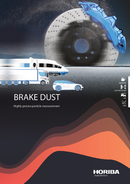

The airborne breathable portion of brake dust particulate contains nanoparticles. These particles are smaller than 10 μm, some are even as small as 2.5 μm, and suspected to have a negative impact on human health when inhaled. Paired with more vehicles on the road, more vehicle miles traveled, and population density concerns (particularly in urban areas) — regulatory bodies are taking notice. Similar concerns also exist for particulates created by tire wear.
Hence the importance of measuring tire and brake emissions.
In Europe, the informal working group of the Particulate Measurement Program (PMP) received a mandate to investigate the topic of brake emissions.
HORIBA Automotive has been an active member in all four task forces within the PMP group. These groups are working on the development of a commonly agreed method for sampling and measuring brake wear particulates. Setting the framework for the test procedure used within the draft UN-GTR GRPE 2023/4, which specifies how brake emissions have to be measured to fulfill Euro 7 standards. Visit our Euro 7 page to learn more about the proposed emission standards, including brake emissions.
The California Air Resource Board (CARB: Vehicle non-exhaust particulate matter sources) also has an ongoing investigation into particulate standards.
We provide complete brake dust measurement solutions to help OEM and brake system suppliers prepare for possible regulations, leveraging our emissions analysis and brake testing expertise.
Further, we offer a range of brake dynamometer test systems. These are robust, compact brake inertia test systems that enable brake system performance, NVH, and brake dust analysis.
In line with the growing appetite for brake dust measurement; particulate measurement can now be performed by measuring particulate matter mass (PM2.5 and PM10). This is done by means of gravimetric filtration, or the total and solid particles (TPN and SPN) can be counted for particulate in the range of 10nm to 2.5um.
Elemental analysis is also available to analyze chemical composition.
Visit HORIBA Scientific for more information.
A solution is only as good as the automation that connects it. STARS Brake Test Automation software helps set up tests, evaluate data, and generates reports meeting the requirements of draft UN-GTR GRPE 2023/4.
Multi-Purpose Brake Dynamometers
Brake Test Systems
Brake Test Systems
Test Automation Software for Brake Testing
Software for Laboratory Management
Digital Controller
Solid Particle Counting System
MicroRaman Spectrometer - Confocal Raman Microscope
Continuous Particulate Monitor with X-ray Fluorescence
Saltwater, Wet and Fog Testing for Brake Dynamometers
Do you have any questions or requests? Use this form to contact our specialists.

